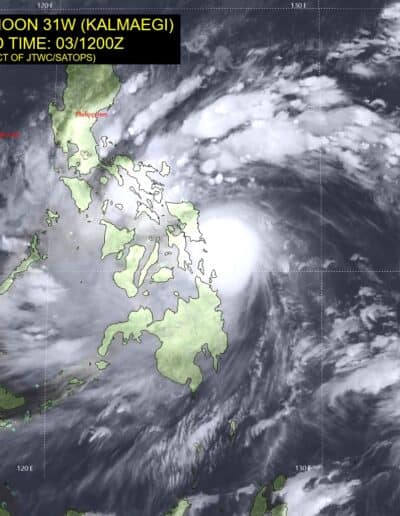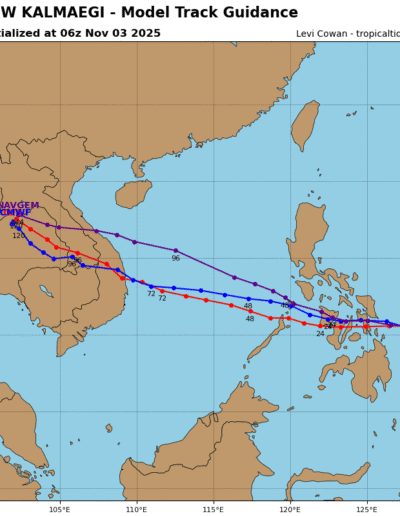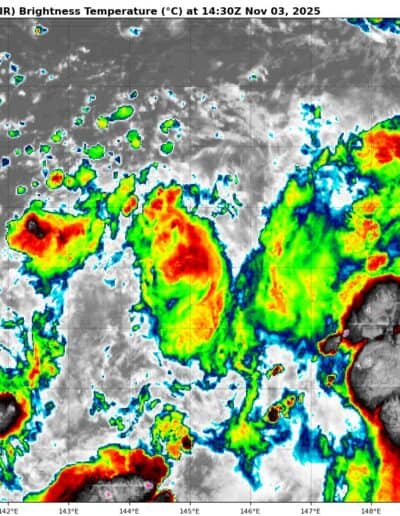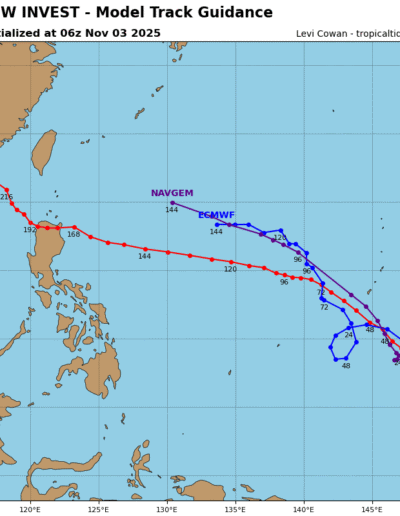The Pacific Disaster Center’s (PDC Global) Monday, November 3, 2025, Tropical Cyclone Activity Report…for the Pacific Ocean, the Indian Ocean, and adjacent Seas
Current Tropical Cyclones:
Tropical Cyclone 31W (Kalmaegi)…is located 289 NM southeast of Manila, Philippines
Northeast Pacific Ocean: There are no Tropical Cyclones
Tropical cyclone formation is not expected during the next 7 days.
Central Pacific Ocean: There are no Tropical Cyclones
Tropical cyclone formation is not expected during the next 7 days.
Western Pacific, Indian Ocean, and adjacent Seas:
Tropical Cyclone 31W (Kalmaegi)
According to the JTWC warning number 11…sustained winds are 80 knots with gusts to 100 knots
Animated enhanced infrared (eir) satellite imagery depicts typhoon 31W (Kalmaegi) with an extremely symmetric and very cold central dense overcast (cdo) directly over the center. The system has about as strong of an appearance as possible without having an eye. as of 031200z, 31W is about 70 NM off the coast of Leyte, with landfall expected in the next 4-6 hours. A 031016z f16 ssmis 91 ghz microwave image revealed a highly compact core with a small microwave eye feature and a defined convective band along the western periphery.
Environmental analysis indicates that 31W is in a favorable environment characterized by strong poleward and equatorward outflow aloft, moderate (15-20 kts) vertical wind shear, and warm (29-30 c) sea surface temperatures.
After making landfall in Leyte in the coming hours, 31W is forecast to gradually turn more northwestward as it rounds the southern periphery of the subtropical ridge to the north. 31W will then track across the Visayas and enter the northern Sulu Sea around 24 hours. The system will then traverse across the South China Sea and make a final landfall in Vietnam. This final landfall is forecast to occur just after 72 hours within central Vietnam.
Regarding intensity, 31W is forecast to weaken marginally through its track through the Visayas due to terrain interaction. The system is forecast to maintain typhoon intensity throughout this time though. After emerging within the Sulu Sea, reintensification will ensue as strong poleward outflow and warm sea surface temperatures create a favorable environment.
Once 31W makes landfall in Vietnam, rugged terrain interaction will rapidly deteriorate the vortex. Complete dissipation is forecast to occur around 96 hours as the remnant vortex tracks into eastern Thailand.
>>> There’s an area of disturbed weather that is being referred to as Invest 90W, which is located approximately 250 NM south of Guam
Multi-spectral satellite imagery (msi) depicts a consolidating low-level circulation with scattered bursts of convection within the southeastern quadrant. 031127z and 031042z ascat passes show a broad and elongated circulation with a swath of 25 kt winds within the eastern periphery.
Winds to both the north and west are much weaker though (10-15 kts) and do not create a defined low-level circulation center (llcc) yet.
Environmental analysis depicts a favorable environment for development with moderate equatorward upper-level outflow, low vertical wind shear of 10-15 kts, and warm sea surface temperatures (sst) of 29-30 c.
Global models agree on the steady consolidation of the system over the next 24 hours as well as a general northwestward track. Gfs, navgem, and gefs are more aggressive in the development of the system compared to ecmwf and ecens, which depict a slower consolidation.
Maximum sustained surface winds are estimated at 18 to 23 knots.
The potential for the development of a significant tropical cyclone within the next 24 hours is high.





